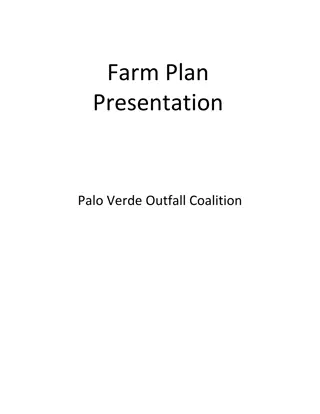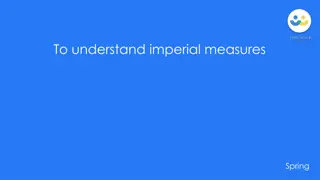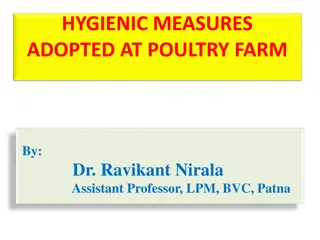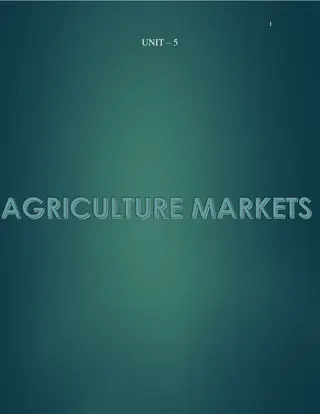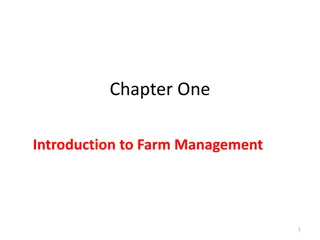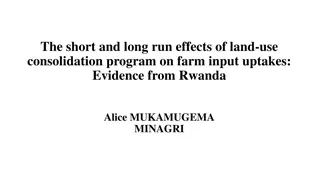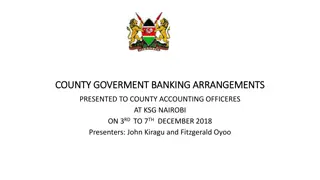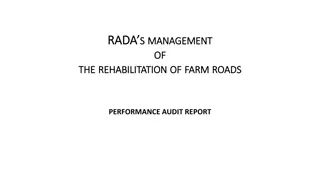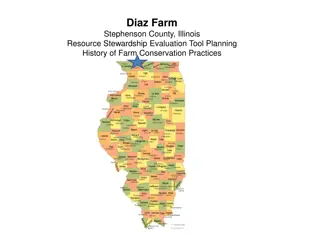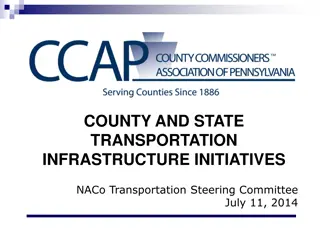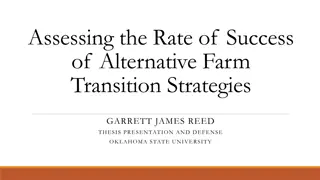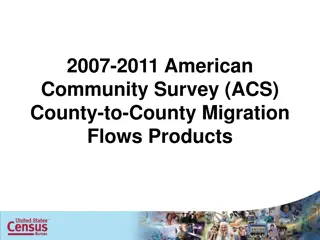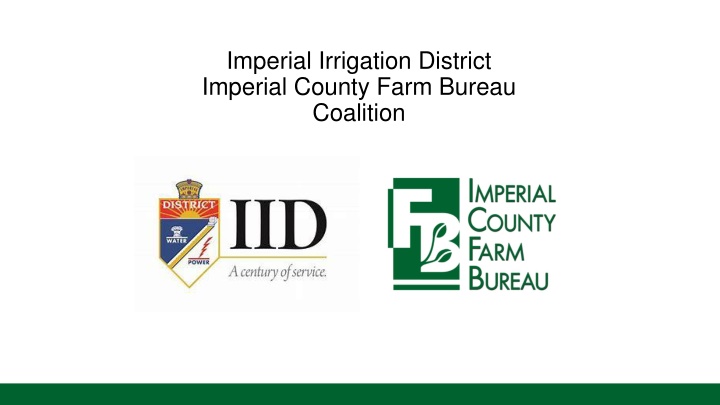
Farming and Water Management in Imperial Valley
Discover the unique farming practices in Imperial Valley, with insights into irrigation methods, surface and groundwater management, and the challenges of maintaining water quality. Learn about the Imperial Irrigation District and its crucial role in sustaining agriculture in the region. Explore the diverse landscapes and crops that contribute to the success of Imperial Valley's farming industry.
Download Presentation

Please find below an Image/Link to download the presentation.
The content on the website is provided AS IS for your information and personal use only. It may not be sold, licensed, or shared on other websites without obtaining consent from the author. If you encounter any issues during the download, it is possible that the publisher has removed the file from their server.
You are allowed to download the files provided on this website for personal or commercial use, subject to the condition that they are used lawfully. All files are the property of their respective owners.
The content on the website is provided AS IS for your information and personal use only. It may not be sold, licensed, or shared on other websites without obtaining consent from the author.
E N D
Presentation Transcript
Imperial Irrigation District Imperial County Farm Bureau Coalition
Imperial Valley Agriculture 456,262 farmable acres 396 farms Average Farm Size: 1,317 acres Over 100 different commodities produced Different soil types, different slopes, different crops, different farm practices and different farmers all contribute to the uniqueness of farming in Imperial Valley as well as to the success of our current silt and sediment TMDL program.
Irrigation in Imperial Valley Colorado River is the sole source of water As a downstream water user on the Colorado River, water delivered to Imperial Valley begins as a moderately saline resource Imperial Irrigation District delivers water through 1,658 miles of canals There are 35,000 miles of tile lines that make farming in Imperial Valley possible by reducing the salinity in soils Salts left from irrigation water must be leached from soils in order to maintain productive land Tailwater and tile water is drained into IID s 1,406 miles of drains which then ultimately flows to the Salton Sea
Surface Water The beneficial uses of surface waters (our drainage system) in the Imperial Valley are limited and changing over time Efficient water conservation practices reduce surface and subsurface run-off volumes which may decrease the dilution factor for constituents such as salinity Increased conservation on farms and in the IID system due to state- mandated QSA Water Transfer
Ground Water No beneficial use of groundwater for domestic or irrigation purposes Montgomery Watson s 1996 Imperial County Groundwater Study Salinity is the primary water quality issue Higher than recommended concentrations of nitrate and fluoride for drinking water are common Poor groundwater quality was accepted under the Imperial Integrated Regional Water Management Plan developed in 2012 by a regional Water Forum
Drinking Water in Imperial Valley Through Safe Drinking Water Program, all households with IID pipe accounts must have contract for drinking water service delivery 3,249connections tracked in the Program Up to $30/month subsidy is available to qualified small acreage service pipe customers for alternative water delivery service based on income requirements and contingent upon enrollment in IID s Residential Energy Assistance Program Residential water service through municipal or private water treatment systems are treated to drinking water standards
IID-ICFB Coalition Imperial County Farm Bureau Staff and on-farm consultant educate growers and landowners on the ILRP and best management practices that can be implemented on their farm. ICFB manages an online reporting system for growers to submit their annual Water Quality Management Plans, and staff provides assistance to growers with their plans as well as follow-up when plans are not completed. Imperial Irrigation District Staff provides the water quality monitoring as well as the billing for the state fee. IID s water quality reports provide the coalition with data that allows us to monitor trends, identify potential threats, and adjust education efforts accordingly. ICFB s On-Farm Consultant The on-farm consultant conducts site visits to ensure BMPs are being implemented and make suggestions. Additionally, the on-farm consultant provides reports and meets regularly with IID staff regarding maintenance of IID drains.
History of the IID-ICFB Coalition In 2001, ICFB s Voluntary Total Maximum Daily Load (TMDL) Program was developed to help irrigated agriculture meet the requirements of the RWQCB s Irrigated Land Regulatory Program (ILRP), and in 2015, the program was switched over to a Conditional Waiver. Both programs have been extremely successful in both grower participation and the resulting water quality improvements. ICFB and IID have worked diligently together as coalition facilitators to educate landowners and farmers in Imperial Valley in order to ensure that we are working towards the overall goal and purpose of the program.
Value of the Coalition High participation rate Number of acres enrolled generating money to the state Positive working relationship between ICFB, IID and Regional Board staff Coalition provides all participant education and outreach, technical assistance, reporting system, monitoring and billing limiting program responsibilities of the RWQCB staff.
2018 Coalition WQMP Numbers 423 members enrolled 5,299 WQMPs filed for 4,874 gates 428,563.45 acres enrolled (93.3% of Imperial Valley Acreage) $388,321.12 paid to the SWRCB through the $0.95 per acre fee
Coalition Outreach TMDL update reminder postcards are sent out annually before the September 1st deadline. A letter outlining the TMDL program and requirements along with the fee schedule are included in the invoices mailed out in November. A TMDL handbook is available to serve as a guide for landowners, farmers and farm employees. It is emailed out to coalition members and published on the ICFB website. Staff conducts outreach to individual noncompliant landowners and farmers through email, text and phone calls. Formal letters are sent to both members who do not update their farm plan by the deadline as well as to landowners who have fields that have not been registered in the coalition. Coalition partners put up a booth at 2 events annually.
Coalition Costs Reporting website Staff time: outreach, one on one assistance to members including on-farm visits, monitoring and data collection, annual reporting, billing Consultant costs Equipment and supplies to implement BMPs by farmers Monitoring equipment
Farmers Implementation of Best Management Practices Example Management Practices Drain Box Wide Pan Ditch Pump-Back Systems Polyacrylamides Drain Water Ditch Checks Additional Water Conservation Methods that reduce tailwater
IID Implementation of Control Practices The IID is currently utilizing several management practices which serve to reduce water quality impairments within the IID drainage system, including: IID Regulation No. 39 GPS-assisted drain cleaning/dredging operations IID s On-Farm Conservation Verification Program (formerly, Tailwater Education Program) Drain Maintenance Checklists Drain Improvement Program to improve problematic drains Vegetation Management Plan
IID Implementation of Control Practices: Standard Method vs. GPS Cleaning Typical Cleaning Operation Work from downstream to upstream Water flows toward disturbed soil GPS-Assisted Cleaning Operation Work from upstream to downstream Water flows toward vegetation Nuisance vegetation = filter strip Prevents over-excavation
IID Monitoring Drain Water Quality Improvement Plan Imperial Irrigation District currently monitors for these constituents as part of their Drain Water Quality Improvement Plan. Monitoring Sites
Agricultural Drain Flows to the Salton Sea Approximately 1,000,000 acre-feet of agricultural drain water flowed to the Salton Sea in 2018, a reduction of 200,000 acre-feet since 2000. That number is expected to continue going down. Mitigation water to the Salton Sea ended in 2017, and QSA transfer volume continues to go up. Almost 500,000 af will be transferred out this Valley annually. The implementation of further management practices and increased limitations for Nitrate may have to be mitigated by eliminating farmland discharge increasing the reduction in flow to the Sea.
Concerns Looking Forward The changes at the Salton Sea require a reevaluation of beneficial uses and create the need for revised water quality objectives. In spite of lack of progress at the Salton Sea by the state, farmers continue to implement BMPs and assist in water quality as they are required through their TMDLs. State must not transfer the responsibility of the Salton Sea from themselves to growers. Cost of impacts from the QSA should be born by the State, not Imperial Valley agriculture. Beneficial uses for drains need to be reevaluated. Potential impacts of additional regulatory programs: Reduced flow to the Salton Sea Financial impacts to the coalition, landowners, and growers Time and money spent on data collection that will go unused as it has the last 15 years Growers should not be responsible for mitigating nitrates when there is no current nitrogen problem in Imperial Valley.
Why an Extension of the Imperial Valley Conditional Waiver is Needed More time is needed to continue to evaluate precedential requirements for nitrogen management plans from East San Joaquin Order While nitrate pollution in groundwater is a significant public health threat in parts of the Central Valley, the ESJ WDR recognizes that its specific nitrogen management requirements should not uniformly apply statewide due to uniquely-situated growers and geographic areas Nitrate pollution in groundwater is not a problem in Imperial Valley The existing poor water quality conditions make the imposition of additional TDMLs moot for the purpose of protecting water quality that is not useful for drinking purposes at any conceivable treatment level.
Why an Extension of the Imperial Valley Conditional Waiver is Needed Additional limitations should not be applied without a reassessment of the beneficial uses of downstream water bodies What is the intent of additional monitoring and reporting in an area that doesn t use groundwater? What adverse impacts to the environment and agricultural economy will be caused and to what benefit? Without the ability to leach salts from their land, Imperial Valley growers would be unable to sustain the production of crops, rendering the land unusable for agriculture. Nitrates will be leached along with the salts. Therefore, it is impossible to completely avoid nitrate discharge.


